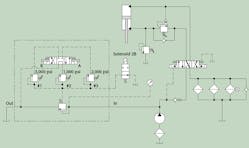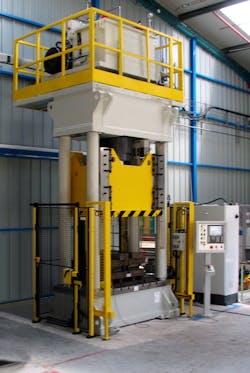A small shop had a 150-ton press it used for producing steel forms shaped like oval cups for one of its customers. It was having problems bending the steel forms and found that it could only get about 2,200 psi maximum pressure from the multi-pressure relief valve. The 8-in. bore ram on the machine needed 3,000 psi setting to make the parts successfully.
The shop’s maintenance crew disconnected the valve labeled 2B in the diagram by plugging its ports, but that did not solve the problem. It then removed all three of the adjustment springs and poppets, hoping to find a problem. When that action did not help restore the pressure, the crew changed the 3-position directional valve. However, when it started to manually shift the valve, the side of the vane pump out blew out. Luckily, no one was hurt and all the crew needed to do was clean up the mess and call for outside help.
This real-world example illustrates how trial-and-error troubleshooting can be unproductive and expensive, but also dangerous. No one should work on hydraulic systems without first undergoing extensive training, and IFPS Fluid Power Certification is a definite plus.
Now, back to the problem: Any idea why the pump exploded, and what caused the low pressure in the first place?
Find the Solution
Think you know the answer to this month’s problem? Submit your solution by e-mailing [email protected]. All correct answers submitted by Sept. 16, 2019 will be entered into a random drawing for a $50 gift card. The winner will be notified, and his or her name will be printed in a future issue. Only one gift card will be awarded to any participant within a calendar year.
Solution to Last Month’s Challenge:
Piston Pump on a Press Makes Knocking Noise
When piston pumps start to produce a knocking noise, it usually is caused by a plugged lubrication hole in a piston shoe. This hole allows pressurized fluid to flow to the piston-shoes surface contacting the swashplate. This floats the shoe on a film of lubricating oil to greatly reduce the friction of the sliding shoe on the fixed swashplate.
After we disassembled the pump, our inspection revealed a small piece of rubber (probably from the new suction hose that had been installed) plugging the hole. The obstruction prevented hydraulic oil from reaching the piston shoe, causing excessive friction and wear of the shoe.




